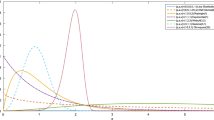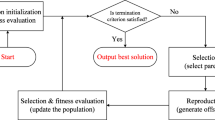Abstract
The GARCH models have been found difficult to build by classical methods, and several other approaches have been proposed in literature, including metaheuristic and evolutionary ones. In the present paper we employ genetic algorithms to estimate the parameters of GARCH(1,1) models, assuming a fixed computational time (measured in number of fitness function evaluations) that is variously allocated in number of generations, number of algorithm restarts and number of chromosomes in the population, in order to gain some indications about the impact of each of these factors on the estimates. Results from this simulation study show that if the main purpose is to reach a high quality solution with no time restrictions the algorithm should not be restarted and an average population size is recommended, while if the interest is focused on driving rapidly to a satisfactory solution then for moderate population sizes it is convenient to restart the algorithm, even if this means to have a small number of generations.



Similar content being viewed by others
References
Adanu, K. (2006). Optimizing the Garch model—An application of two global and two local search methods. Computational Economics, 28, 277–290.
Alander, J. T. (1992). On optimal population size of genetic algorithms. In Proceedings of CompEuro92 (pp. 65–70). Washington: IEEE Computer Society Press.
Baragona, R., Battaglia, F., & Poli, I. (2011). Evolutionary statistical procedures—An evolutionary computation approach to statistical procedures design and applications. Berlin: Springer.
Bollerslev, T. (1986). Generalized autoregressive conditional heteroskedasticity. Journal of Econometrics, 31, 307–327.
Bollerslev, T., & Ghysels, E. (1991). Periodic autoregressive conditional heteroskedasticity. Journal of Business & Economic Statistics, 14(2), 139–151.
De Jong, K. A. (1975) An analysis of the behaviour of a class of genetic adaptive systems. Ph.d Thesis, Dept. of Computer and Communication Sciences University of Michigan, Ann Arbor
Engle, R. (1982). Autoregressive conditional heteroskedasticity with estimates of the variance of U.K. inflation. Econometrica, 50, 987–1008.
Fan, J., & Yao, Q. (2003). Nonlinear time series: Nonparametric and parametric models. New York: Springer.
Fukunaga, A. S. (1998). Restart scheduling for genetic algorithms. Lecture Notes In Computer Science, 1498, 357–366.
Geng, L., & Zhang, Z. (2015). Forecast of stock index volatility using grey garch-type models. The Open Cybernetics & Systemics Journal. doi:10.2174/1874110X01509010093.
Ghannadian, F., Alford, C., & Shonkwiler, R. (1996). Application of random restart to genetic algorithms. Intelligent Systems, 95, 81–102.
Goldberg, D. E. (1989). Sizing populations for serial and parallel genetic algorithms. In J. D. Schafer (Ed.), Proceedings of the 3d conference of genetic algorithms (pp. 70–79). San Mateo: Morgan Kaufman.
Grefenstette, J. J. (1992). Genetic algorithms for changing environments. In R. Manner & B. Manderick (Eds.), Parallel problem solving from nature 2 (pp. 137–144). Amsterdam: Elsevier.
Holland, J. H. (1975). Adaptation in natural and artificial systems. Ann Arbor: University of Michigan Press.
Hung, J. (2009). A fuzzy GARCH model applied to stock market scenario using a genetic algorithm. Expert Systems with Applications, 36, 11710–11717.
Misevicius, A. (2009). Restart-based genetic algorithm for the quadratic assignment problem. In M. Bramer, F. Coenen, & M. Petridis (Eds.), Research and development in intelligent systems XXV—proceedings of AI-2008 (pp. 91–104). London: Springer.
Phanden, R. K., Jain, A., & Verma, R. (2012). A genetic algorithm-based approach for job-shop scheduling. Journal of Manufacturing Technology Management, 23(7), 937–946.
R Core Team (2013) R: A language and environment for statistical computing. Vienna: R Foundation for Statistical Computing. http://www.R-project.org/.
Rudolph, G. (1997). Convergence properties of evolutionary algorithms. Hamburg: Verlag Dr. Kovac.
Santamaría-Bonfil, G., Frausto-Solís, J., Vzquez-Rodarte, I., (2015). Volatility forecasting using support vector regression and a hybrid genetic algorithm. Computational Economics. doi:10.1007/s10614-013-9411-x.
Wang, C., & Li, G. (2001). Improving the estimations of Var-GARCH using genetic algorithm. Journal of Systems Science and Systems Engineering, 10(3), 281–290.
Winker, P. (2006). The stochastic of threshold accepting: analysis of an application to the uniform design problem. In A. Rizzi & M. Vichi (Eds.), COMPSTAT 2006—Proceeding in Computational Statistics (pp. 495–503). Heidelberg: Physica-Verlag.
Winker, P., & Gilli, M. (2004). Applications of optimization heuristics to estimation and modelling problems. Computational Statistics & Data Analysis, 47, 211–223.
Winker, P., & Maringer, D. (2009). The convergence of estimators based on heuristics: Theory and application to a GARCH model. Computational Statistics, 24, 533–550.
Wuertz, D., et al. (2013). fGarch: Rmetrics—Autoregressive conditional heteroskedastic modelling. R package version 3010.82. http://CRAN.R-project.org/package=fGarch.
Zumbach, G. (2000). The pitfalls in fitting GARCH processes. In C. Dunis (Ed.), Advances in quantitative asset management. Amsterdam: Kluver.
Acknowledgments
The authors wish to thank Peter Winker for useful suggestions, and an anonymous referee for valuable comments.
Author information
Authors and Affiliations
Corresponding author
Rights and permissions
About this article
Cite this article
Rizzo, M., Battaglia, F. On the Choice of a Genetic Algorithm for Estimating GARCH Models. Comput Econ 48, 473–485 (2016). https://doi.org/10.1007/s10614-015-9522-7
Accepted:
Published:
Issue Date:
DOI: https://doi.org/10.1007/s10614-015-9522-7




